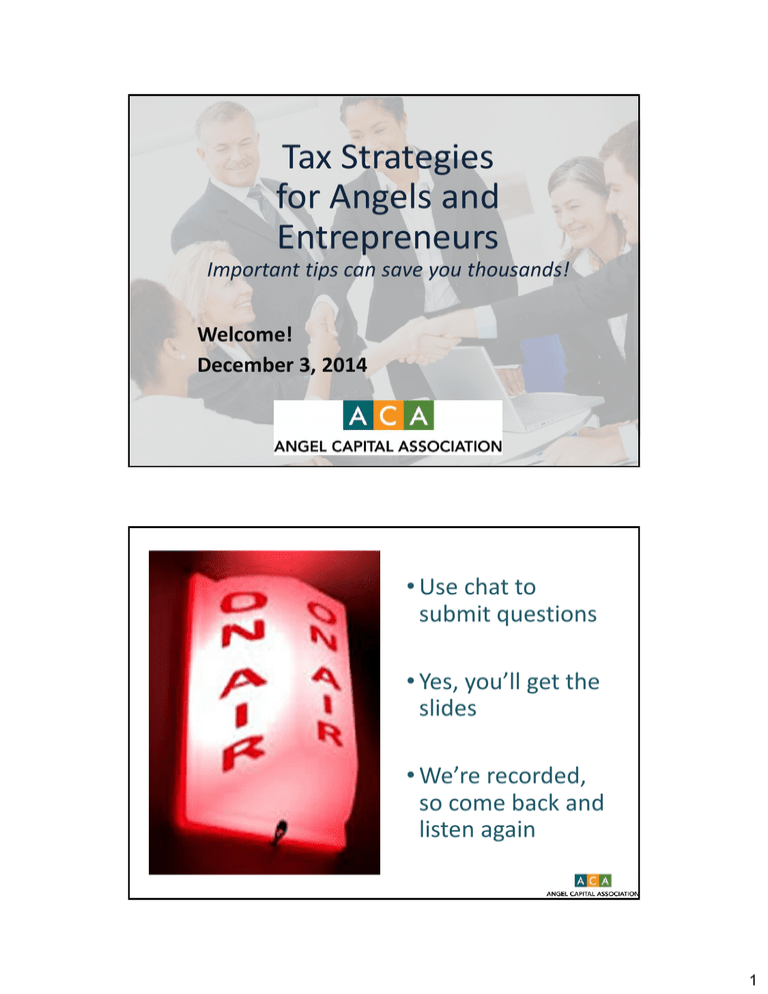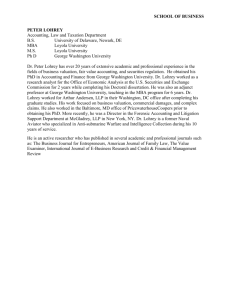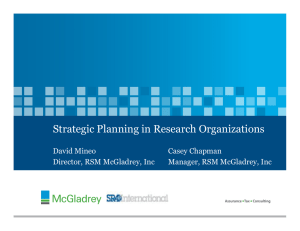
Tax Strategies
for Angels and
Entrepreneurs
Important tips can save you thousands!
Welcome!
December 3, 2014
• Use chat to
submit questions
• Yes, you’ll get the
slides
• We’re recorded,
so come back and
listen again
1
Mission:
Fuel the success of angel groups and accredited individuals active
in the early-stage landscape
• World’s largest trade group for angel investors
220+ angel groups
o 12,000 accredited investors
o Voice of accredited individuals,
portals, and family offices
o
• 50 US states + Canada
• Research/ education partner
Member Groups & Accredited Platforms
New Dominion Angels
2
ACA Partners
Today’s Presenters
Glenn Martin
Lead Tax Senior Manager
Columbus, OH
Mark Blawas
National Leader,
Director, Credits and Incentives
Chicago, IL
Ed Decker
Senior Manager,
Washington National Tax
Davenport, IA
Chuck Schultz
Partner, Estate & Gift Tax Practice,
Washington National Tax
Chicago, IL
3
McGladrey overview
Fifth largest U.S. provider of assurance, tax and
consulting services
Over $1.47 billion in revenue
75 cities and more than 7,000 employees in the
United States
Internationally*
-
Presence in 110 countries
More than 32,000 people in over 700 offices
$3.7 billion (U.S.) in worldwide revenues
* Member of the RSM International network of independent
accounting, tax and consulting firms.
7
© 2014 McGladrey LLP. All Rights Reserved.
Agenda
Topic
Presenter
Tax legislation and extenders, IRC Section
1202/1244 and more
Glenn Martin
Year-end tax planning – net investment income
tax, update for self employment tax and more
Ed Decker
Business start ups – don’t leave money on the
table
Mark Blawas
Year-end estate planning update
Charles Schultz
8
© 2014 McGladrey LLP. All Rights Reserved.
4
End of year tax strategies for
angels and entrepreneurs
- Tax legislation and extenders
- IRC 1202/1244
- Tax planning update
© 2014 McGladrey LLP. All Rights Reserved.
The legislative scorecard–A short postelection analysis
What we should expect post elections
Without a super majority in the Senate,
bi-partisanship will be a requirement
New hope related to tax extender legislation?
At least in the short term, dramatic changes in the
individual tax legislation are highly unlikely
10
© 2014 McGladrey LLP. All Rights Reserved.
5
Qualified small bus stock–IRC section 1202
Know what you are investing in–before you invest
-
Get documentation as you finalize the investment
Support for eventual positioning for 1202 or 1244
QSBS–1993 tax law to spur start up investment
-
the greater of 10 times the investment or $10 million
QSBS–50 to 100 percent exclusion of the gain
-
Gain exclusion varies depending on year of investment
Might want to use IRC 1045 rollover if tax math is better
11
© 2014 McGladrey LLP. All Rights Reserved.
IRC section 1244 stock
Capital loss vs. ordinary loss
Up to $50,000/$100,000 per year
First $1 million of capital raised
Documentation is easier to get when you make the
investment rather than when you incur the loss. It is
also more reliable if done at time of investment.
12
© 2014 McGladrey LLP. All Rights Reserved.
6
End of year tax strategies for
angels and entrepreneurs
© 2014 McGladrey LLP. All Rights Reserved.
Planning strategies–Manage adjusted gross
income (AGI)
Above the line adjustments (AGI)
-
AGI is key to Medicare tax and phase-outs
Defer income–manage Medicare and AGI phase-out
thresholds
Harvest capital losses
Maximize deductible retirement plan contributions
Managing Schedule C and Schedule E losses
14
© 2014 McGladrey LLP. All Rights Reserved.
7
Planning strategies–Manage deductions
Harvesting tax deductions
-
Calculate AGI to assess exposure to phase-outs
Properly planned itemized deductions may provide 43.4
percent federal tax benefit
Examine your flow through/personal businesses
• Accelerate/decelerate bonuses/other expenses
• Section 179, tax credits and manufacturing incentives
• Capture flow through non-resident taxes
15
© 2014 McGladrey LLP. All Rights Reserved.
Net investment income tax
(section 1411)
Presented by Ed Decker
© 2014 McGladrey LLP. All Rights Reserved.
8
Overview
Effective for tax years beginning after December 31, 2012
Section 1411 imposes 3.8% tax for:
-
-
Individuals:
• Applies on the lesser of:
- Net investment income, or
- Modified adjusted gross income above
◦ $250,000 (married filing joint return)
◦ $200,000 (all other filers)
Estates and trusts:
• Applies on the lesser of:
- Undistributed net investment income, or
- The excess of adjusted gross income over the dollar
amount at which the highest tax bracket begins for such
taxable year.
◦ 2014–highest bracket begins at $12,150
17
© 2014 McGladrey LLP. All Rights Reserved.
Overview
Net investment income
Includes:
•
Interest
Does NOT Include:
•
Dividends
•
Salary, wages, or bonuses
•
Annuity Distributions
•
Distributions from IRAs or qualified
plans
•
Rents
•
•
Royalties
Any income taken into account for
self-employment tax purposes
•
Income derived from passive activity
•
Gain on the sale of an active interest
in a partnership or S corporation
•
Income from trade or business of
trading in financial instruments or
commodities
•
•
Net capital gain derived from the
disposition of property
Items which are otherwise excluded
or exempt from income under the
income tax law, such as interest from
tax-exempt bonds, capital gain
excluded under IRC 121, and
veterans benefits
18
© 2014 McGladrey LLP. All Rights Reserved.
9
Planning opportunities
Regrouping activities
Activities conducted through pass-through
Activities conducted directly
Significant participation activities
Threshold is > 100 hours
Documenting participation
Dispositions of interests in S corporations,
partnerships (but not C corporations)
Recharacterizations
Rent
Interest
19
© 2014 McGladrey LLP. All Rights Reserved.
Self-employment tax
© 2014 McGladrey LLP. All Rights Reserved.
10
Self-employment tax
Continuing area of uncertainty
Statutory provisions
Proposed regulations – issued ’97 but
never finalized
Recent court decisions, guidance
-
Renkemeyer, Howell, Riether
CCA 201436049
21
© 2014 McGladrey LLP. All Rights Reserved.
Planning opportunities
Groupings for passive activity/net investment
income tax purposes don’t necessarily impact selfemployment tax calculations
Consider statutory provision for limited partners
Flow through income from S corporations not
subject to self-employment taxes
Consider carve out for income representing return
on capital
22
© 2014 McGladrey LLP. All Rights Reserved.
11
Other recent guidance
© 2014 McGladrey LLP. All Rights Reserved.
Other recent guidance
Abandonment of partnership interests
Prior guidance indicated ordinary (rather than capital) loss
might be allowed
Recent court decision (Pilgrim’s Pride) creates some
uncertainty
Issuance of capital vs. profits interests to key
employees
Should a Section 83(b) election be made?
Crescent Holdings decision demonstrates importance of
understanding type of interest being issued
24
© 2014 McGladrey LLP. All Rights Reserved.
12
State and local tax credits and
incentives: The current
environment
Presented by Mark Blawas
© 2014 McGladrey LLP. All Rights Reserved.
Trends in state and local incentives
State and local economic development agencies
are aggressively pursuing companies to expand in
their jurisdiction
More states privatizing the Economic Development
Authority
States pulling back on job retention tax credits
Increasing scrutiny of incentives programs
Expanded audit activity of tax incentives by taxing
authorities
Funding caps on incentives programs designed to
minimize state budget impact
26
© 2014 McGladrey LLP. All Rights Reserved.
13
Benefits to your business
A variety of programs exist at the federal, state and
local levels to reward businesses for investing in
growth
Participation in credits and incentives programs
may provide significant bottom line benefits
including
-
Permanent tax savings
Reduced effective tax rate
Enhanced cash flow
Reduced start-up or operational costs
Increased shareholder value
27
© 2014 McGladrey LLP. All Rights Reserved.
Types of incentives
Statutory
Discretionary or
negotiated
Clear requirements, available to
all qualifying companies
Must be secured or preapproved in advance of
qualifying activities taking place
May require pre-approval or
prior certification
Claimed on a tax return
Offset federal or state income
and franchise tax liabilities
May offset sales and use,
property or employment taxes
Allowed by statute, benefits may
range based on facts
Boundaries are less clear,
allocated at the discretion of the
controlling government agency
Can be customized to
company’s specific facts
28
© 2014 McGladrey LLP. All Rights Reserved.
14
Types of credits and incentives available
Angel
investment tax
credits
R&D tax credits
Investment tax
credits
Job creation or
retention tax
credits
Cash grants for
training and
hiring
Favorable or
forgivable loans
Sales and use
tax exemptions
or credits
Property tax
abatements or
reductions
Utility
exemptions
(cost and tax)
Specifically designated
zone benefits
Other economic
development
benefits
29
© 2014 McGladrey LLP. All Rights Reserved.
Common qualifiers for credits and incentives
Job creation or retention
Capital investment (e.g., facilities and equipment)
Expansions and relocations
Renewing long-term leases
Acquiring or restructuring a company
Research and development
Located or locating business in a specific area
Training of new and existing employees
Producing energy from renewable sources
Manufacturing or production
30
© 2014 McGladrey LLP. All Rights Reserved.
15
Angel investor tax incentive programs, by
state
Arkansas Equity Investment Incentive Act of 2007
Arizona Angel Investment Tax Credit
Colorado Enterprise Zone Tax Credit
Connecticut Angel Investor Tax Credit
Georgia Angel Investor Tax Credit
Illinois Angel Investment Tax Credit
Indiana Venture Capital Investment Tax Credit
Kansas Angel Investor Tax Credit
Louisiana Angel Investor Tax Credit
Maine High Technology Investment Tax Credit
Maryland Biotechnology Investment Tax Credit
Minnesota Seed Capital Investment Credit
Nebraska Angel Investment Tax Credit Program
New Jersey High Technology Investment Tax
Credit
New Mexico Tax Credit
North Carolina Qualified Business Investment Tax
Credit
North Dakota Seed Capital Investment Tax Credit
Ohio Technology Investment Tax Credit and Invest
Ohio
Oklahoma Small Business Capital Credit
Oregon University Venture Development Fund Tax
Credit
Rhode Island Innovation Tax Credit
South Carolina Bill Wylie Entrepreneurship Act
Vermont Angel Venture Investment Capital Gain
Deferral Credit
Virginia Qualified Equity and Subordinated Debt
Investments Credit
West Virginia High Growth Business Investment
Tax Credit
Wisconsin Angel Investor Tax Credit
© 2014 McGladrey LLP. All Rights Reserved.
Best practices
Start early - more options exist when planning is
still open
Research continually to stay aware of programs
Know the qualifiers and understand the
commitment
Establish a process or partner with someone who
can provide a process
Develop a media response—significant credits are
newsworthy
32
© 2014 McGladrey LLP. All Rights Reserved.
16
Common pitfalls
× Process started too late
× Lack of awareness–not all opportunities are widely
publicized
× Inaccurate or incomplete documentation
× Overpromises on investments or jobs–potential for
missed goals
× Failure to timely and accurately comply with
reporting and maintenance procedures
× Premature announcements invalidate eligibility
× Assumption of ineligibility
33
© 2014 McGladrey LLP. All Rights Reserved.
2014 year-end estate planning
update
Presented by Charles Schultz
© 2014 McGladrey LLP. All Rights Reserved.
17
Overview of the 2015 estate tax schedule
Maximum tax bracket
Lifetime exemption
2013
2014*
2015*
40%
40%
40%
$5,250,000
$5,340,000
$5,430,000
Annual exclusion
$14,000
$14,000
$14,000
Foreign spousal
exclusion
$143,000
$145,000
$147,000
* Adjusted by inflation
35
© 2014 McGladrey LLP. All Rights Reserved.
Basic gift planning
Outright gifts
“KISS” method of planning (keep it simple)
Seize the valuation discount opportunities where
appropriate
-
Liquidity/non-marketability of closely held interests
Minority interests in closely held corporations or noncontrolling interests in a limited partnership
Potential state estate tax savings
36
© 2014 McGladrey LLP. All Rights Reserved.
18
The key driver to year-end planning–The
current economic environment
Interest rates remain near historical lows
-
Leverage modest lifetime exclusion through grantor
retained annuity trusts and sales to grantor trusts
Take advantage of the low interest rate environment (e.g.,
the December 2014 section 7520 rate is a modest 2.0
percent)
Can use this rate the following two months
Take advantage of valuation discounts between related
parties
37
© 2014 McGladrey LLP. All Rights Reserved.
Low interest rate environment and leveraging
gifts
Great strategies for those who have already utilized
their $5.34 million lifetime exemption
Grantor retained annuity trusts (GRATs)
-
Two advantages
• Banking the valuation discount
• Banking the capital appreciation
• Strategy–funding the GRAT with an LLC holding liquid
assets
Sale to a defective grantor trust
-
Using the low applicable federal rates
Avoidance of capital gain recognition
38
© 2014 McGladrey LLP. All Rights Reserved.
19
Grantor retained annuity trust (GRAT)
Grantor Retained Annuity Trust
"GRAT"
Gift of remainder
interest in assets
Donor
Trust
Annuity for term of years
At end of term
Remainder
Beneficiaries
39
© 2014 McGladrey LLP. All Rights Reserved.
Zeroed out or “Walton” GRAT and transfers of
closely held interests–example
$1 million S corporation value
-
32 percent valuation discount creates a $680,000 value
$680,000 is used to calculate the annuity payment
GRAT is calculated to create a nominal gift tax
liability
40
© 2014 McGladrey LLP. All Rights Reserved.
20
Zeroed out or “Walton” GRAT and transfers of
closely-held interests–example (cont.)
1,000 shares valued at $680,000
$134,379 Year 1 payment*
Parent
$161,255 Year 2 payment*
$193,506 Year 3 payment*
Trust
4 years
$232,207 Year 4 payment*
Remainder after 4 years
Taxable gift
To children
Property transferred $ 680,000
Retained annuity
( 679,999)
Taxable gift
$
1
Remainder interest:
$126,774**
Banked discount
$320,000
*Assumes section 7520 rate of 2.2 percent. ** Assumes a 5 percent growth of $1,000,000 S corporation value
41
© 2014 McGladrey LLP. All Rights Reserved.
Sale to a defective trust
Sale to intentionally defective grantor trust (IDGT)
-
Estate freezing technique
Rate arbitrage–low interest rate note in exchange for a
high appreciating asset
Non-recognition of capital gain
42
© 2014 McGladrey LLP. All Rights Reserved.
21
Sale to a defective trust (cont.)
Assumptions: Grantor holds shares of
ABC S corporation worth $1.385 million
1. Gift – Seed money ($100K)
Grantor
2. Sale - Discounted interest in ABC
($900K assuming 35% discount)
IDGT
$900K promissory note
30 year term
3.00% interest rate
Children /
Grandchildren
43
© 2014 McGladrey LLP. All Rights Reserved.
Sale to a defective trust (cont.)
Capital gain recognition–the unintended turning off
of the defect
Flow through entities
•
•
IRS crackdown of tax driven LLCs and family limted
partnerships
Important elements required
- Business purpose test
- Lack of marketability discount
44
© 2014 McGladrey LLP. All Rights Reserved.
22
Thank you
Glenn Martin
Lead Tax Senior Manager
614-456-2763
Glenn.Martin@mcgladrey.com
Mark Blawas
National Leader, Director, Credits
and Incentives
312-634-3400
Mark.Blawas@mcgladrey.com
Ed Decker
Senior Manager, Washington
National Tax
563-888-4052
Ed.Decker@mcgladrey.com
Chuck Schultz
Partner, Estate & Gift Tax Practice,
Washington National Tax
312-634-5373
Charles.Schultz@mcgladrey.com
45
© 2014 McGladrey LLP. All Rights Reserved.
This document contains general information, may be based on authorities that are subject to change, and is not a substitute for professional advice
or services. This document does not constitute assurance, tax, consulting, business, financial, investment, legal or other professional advice, and
you should consult a qualified professional advisor before taking any action based on the information herein. McGladrey LLP, its affiliates and
related entities are not responsible for any loss resulting from or relating to reliance on this document by any person.
McGladrey LLP is an Iowa limited liability partnership and the U.S. member firm of RSM International, a global network of independent accounting,
tax and consulting firms. The member firms of RSM International collaborate to provide services to global clients, but are separate and distinct legal
entities that cannot obligate each other. Each member firm is responsible only for its own acts and omissions, and not those of any other party.
McGladrey LLP
800.274.3978
www.mcgladrey.com
McGladrey®, the McGladrey logo, the McGladrey Classic logo, The power of being understood®, Power comes from being understood®, and
Experience the power of being understood® are registered trademarks of McGladrey LLP.
© 2014 McGladrey LLP. All Rights Reserved.
© 2014 McGladrey LLP. All Rights Reserved.
23
Additional Resources
Marianne Hudson
Executive Director
Angel Capital Association
Christopher Mirabile
Managing Director, Launchpad;
Vice Chair, Angel Capital
Association
http://www.angelcapitalassociation.org
/news-forbes/
http://www.angelcapitalassociation.org/
news-inc/
Thank you!
Audience Questions
Save the date!
2015 ACA Summit
April 14 – 16, 2015, San Diego
Webinar programs archived at:
www.angelcapitalassociation.org/events/webinars/
24



